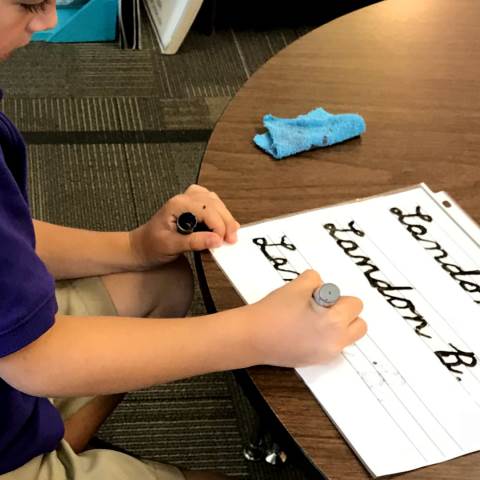

Beginning in the fall of the 2018-2019 school year, Darlington School adopted a new method for teaching reading. After looking at many options, the committee that was tasked to choose an approach settled on the Orton Gillingham method of literacy instruction. This is an evidence-based method which is differentiated by its explicit instruction in all areas of reading.
Before going too deep into the OG method, think back to your own experience and how you learned to spell and read. Many of us received long lists of words to memorize, we were assessed and moved on. Lots of copying words over and over and writing sentences to show meaning. This worked for some of us, but research tells us that children need a phonetic code to be able to figure out more complex words and have long term success with language.
Reading is not a natural ability like spoken language and requires explicit instruction. Our goal is to deliver the best practices in literacy development and through OG we feel this happens. In the spring of 2018, all of the pre-K to fifth grade teachers went through the Orton Gillingham classroom educator class. This approach to literacy is most often associated with small group instruction. The method is characterized as being explicit, multisensory, diagnostic and prescriptive. Explicit instruction is intentional and direct. Multisensory instruction uses as many of the senses as possible, especially the auditory, visual and kinesthetic senses. The OG method is diagnostic in that the teacher is constantly diagnosing the needs of the student during the course of the lesson. It is prescriptive in that as weaknesses and needs are identified, a plan is put in place to address those needs.
This is the hallmark of the OG approach. At Darlington, the teachers divide the class up into small groups and deliver daily instruction in this way around a space where the student receives feedback immediately. The groups often change throughout the year and though there is a sequence, students can be at different places on that sequence based on the need.
Another component to our curriculum is teaching cursive handwriting. Cursive is easier to learn due to the fact that some printed letters, like b, d and p, look similar to some students. In cursive they do not look similar, so it lessens reversals. Cursive also stimulates the brain in ways typing cannot and it aids with spelling through muscle memory.
Using the OG method to teach literacy and teaching cursive handwriting are two of the components Darlington’s Pre-K to second grade curriculum. Both draw upon current brain research and are evidence based best practices for teaching all students to read and write.